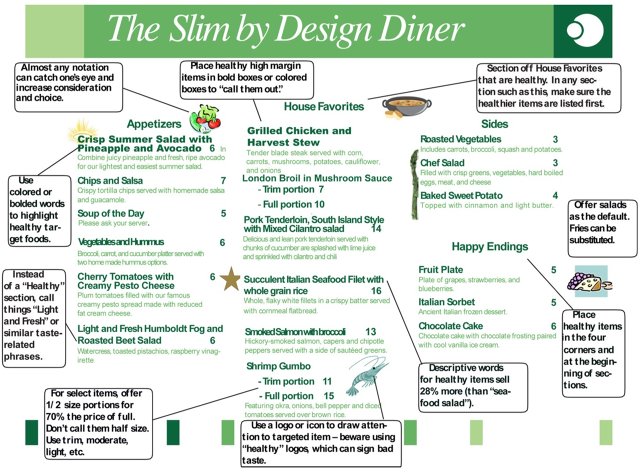Responding to the rise of American obesity rates, some politicians have proposed regulations that would require restaurateurs to reduce portion sizes, eliminate drive-thrus, and limit soft drink sizes. Brian Wansink, author of Slim By Design, marketing professor, and the director of the Cornell Food and Brand Lab, thinks the restaurant industry can police itself--and make more money--by leveraging the power of menu design.
In a recent paper published in the International Journal of Hospitality Management, Wansink argues that hacking menus to better emphasize healthier, lower-calorie choices with higher profit margins would have a positive impact on both the health of restaurant goers and the financial health of the food industry. The paper is based on the analysis of previous research, including lab studies in cafeterias and restaurants.

The trick, Wansink says, is to entice customers to make healthier choices by shifting their visual attention when looking at a menu, making healthier food sound tastier, and increasing the perceived value of these items.
Shifting Expectation
All too often, when customers pick up a menu, they skim right through it to find what they already think they want to order. It doesn't matter how good a restaurant's salads are if you can't keep a customer from heading straight to the burger section.
Wansink suggests a number of ways to flag down the attention of these menu skimmers, some of it based on studies going back as far as 1980. He points out that there's been much research showing how restaurants can use bolder colors, a contrasting font, or graphics to make customers more easily notice the healthy options.

Another trick, Wansink says, is to place healthier, lower-cost entrees around the restaurant's most expensive item, known as a menu anchor. By positioning the anchor in a prominent place on the menu, like the first page, a restaurant can make the entrees that surround it look like comparative deals.
Likewise, most customers read menus the way they read magazines, scanning the four corners of every page and then flipping to the next one. By placing healthier choices in these four corners, which naturally draw our attention when we skim, a restaurant can boost sales of lower-calorie meals.
Making Healthy Food Sound Better
Words have power, especially when it comes to menu copywriting. In fact, some studies have indicated that the words used to describe an item on a menu can boost sales by as much as 27%. Kids, for example, are much more likely to order X-Ray Vision Carrots than plain old carrots, and adults are more likely to be drawn to to Succulent Italian Seafood Filet than to fish sticks. No wonder, then, that modern menus are filled with such elaborate and prosaic descriptions.
But Wansink thinks restaurants can do a better job of using language to push healthier choices, by contrasting highly prosaic menu names for low-calorie items with less evocative descriptions for junk food. Compare the plain "Cheeseburger" with the "Succulent Italian Seafood Fillet." Just by holding back the adjectives from the cheeseburger, the seafood fillet looks more enticing.

Wansink also thinks that when it comes to naming healthier food, restaurants should take cues from what works in selling high-calorie items. The velvet in Velvety Chocolate Mousse can just as easily be applied to Velvety Mashed Cauliflower, while the Southwestern Tex-Mex Salad could become the Southwestern Kale Salad. Restaurant owners shouldn't waste their best adjectives on their worst food.
Increasing Perceived Value
Restaurants already use a number of hacks to make you think the food you're ordering is cheaper than it already is. For example, they might list an entree without using a "$" symbol in order to downplay the item's price. A menu might stagger the alignment of prices, so patrons can't just skim a single column to find the cheapest item. Or a restaurant might anchor the highest margin items in the corners of the menu, where patrons are most likely to see them, to maximize profit.
With a few tweaks, all of these techniques can be used to better emphasize the value of healthy choices to customers. According to Wansink, healthier food tends to be easier to prepare, and offer a greater profit margin than more caloric options: on a menu, a Caesar Salad might be priced the same as a cheeseburger, but it costs less to make. Keeping the price of these items low while emphasizing their affordability in large type and anchoring them in the corners of a menu can help restaurants be more profitable, while encouraging customers to eat healthier at the same time.
Wansink's suggestions for healthy menu hacks don't end there. He also advises restaurateurs to consider offering half-size portions of entrees for 70% of the price, and making salads the default side order with most menu items instead of fries. But at the end of the day, Wansink thinks that the biggest impact on both profit margins and the health of customers can be made by using clever typography, bold colors, smart writing, and intelligent layout techniques to hack our existing menus into being healthier. "It's win-win," he says.